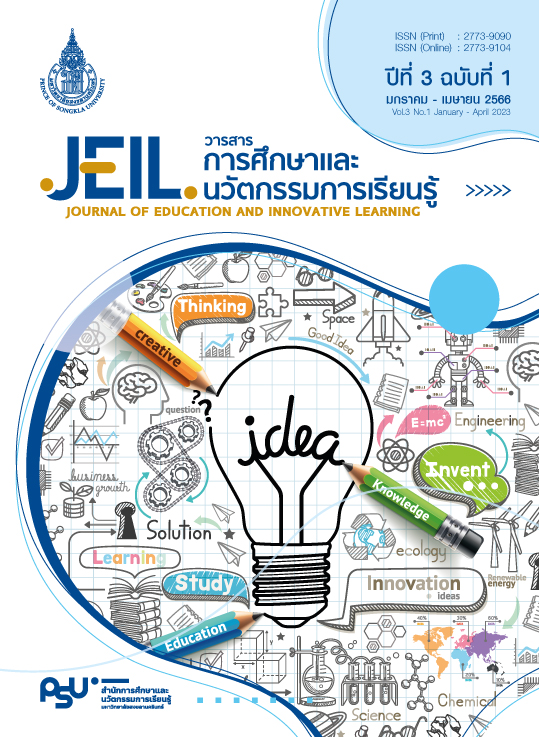การจัดการเรียนรู้ด้วยกระบวนการ GPAS 5 Steps เพื่อส่งเสริมความเป็นนวัตกรของนักเรียนระดับการศึกษาขั้นพื้นฐาน
Main Article Content
บทคัดย่อ
กระบวนการจัดการเรียนรู้เพื่อส่งเสริมความเป็นนวัตกรของนักเรียนในระดับการศึกษาขั้นพื้นฐาน สามารถใช้วิธีการจัดการเรียนรู้ได้หลากหลายผ่านการออกแบบกิจกรรมการเรียนรู้ให้สอดคล้องกัน แต่อย่างไรก็ตาม GPAS 5 Steps เป็นอีกกระบวนการหนึ่งที่มีแต่ละขั้นตอนการจัดการเรียนรู้สอดคล้องกับความเป็นนวัตกร บทความนี้จึงมีวัตถุประสงค์เพื่อนำเสนอแนวคิดการจัดการเรียนรู้ด้วยกระบวนการ GPAS 5 Steps เพื่อส่งเสริมความเป็นนวัตกรของนักเรียนในระดับการศึกษาขั้นพื้นฐาน สาระสำคัญของบทความ ได้แก่ 1) แนวคิดของกระบวนการ GPAS 5 Steps ที่ส่งเสริมการสร้างนวัตกรรม ซึ่งเป็นกระบวนการจัดการเรียนรู้ที่ลำดับการคิดขั้นสูงเพื่อให้ได้มาซึ่งการสร้างนวัตกรรมประกอบด้วย 5 ขั้นตอน ได้แก่ ขั้นสังเกตรวบรวมข้อมูล (G) ขั้นวิเคราะห์และสรุปความรู้ (P) ขั้นประยุกต์และสร้างองค์ความรู้ (A1) ขั้นการใช้ทักษะการสื่อสาร (A2) และขั้นควบคุมตนเอง (S) 2) คุณสมบัติสำคัญของความเป็นนวัตกร ได้แก่ การมีกระบวนการ พัฒนานวัตกรรม ทักษะการคิดเชิงนวัตกรรม และสมรรถนะการคิดเชิงนวัตกรรมที่ดี และ 3) ความสอดคล้องกันระหว่างขั้นตอนการจัดการเรียนรู้ด้วยกระบวนการ GPAS 5 Steps กับคุณสมบัติสำคัญของความเป็นนวัตกร คือ การมีกระบวนการพัฒนานวัตกรรม ทักษะการคิดเชิงนวัตกรรม และสมรรถนะการคิดเชิงนวัตกรรมที่ดีของนักเรียนสามารถพัฒนาได้พร้อมกันด้วยกระบวนการ GPAS 5 Steps แต่ละขั้นตอนอย่างลงตัว และสามารถส่งเสริมให้นักเรียนมีสมรรถนะทางนวัตกรรมที่ดีได้ในอนาคต
Article Details

อนุญาตภายใต้เงื่อนไข Creative Commons Attribution-NonCommercial-NoDerivatives 4.0 International License.
เนื้อหาและข้อมูลในบทความที่ตีพิมพ์ในวารสารการศึกษาและนวัตกรรมการเรียนรู้ ถือเป็นข้อคิดเห็นและความรับผิดชอบของผู้เขียน ซึ่งกองบรรณาธิการวารสาร ไม่จำเป็นต้องเห็นด้วยหรือร่วมรับผิดชอบใด ๆ และไม่สงวนสิทธิ์การคัดลอกบทความเพื่อใช้ประโยชน์ทางวิชาการ แต่ให้อ้างอิงข้อมูลแสดงที่มาของบทความทุกครั้งที่นำไปใช้ประโยชน์
เอกสารอ้างอิง
Australian National Training Authority. (2002). Innovation ideas that work for training package developers. Brisbane: Australian National Training Authority.
Bureau of Educational Innovation Development. (2008). Thinking development. “Using the GPAS process”. Bangkok: Author. [in Thai]
CDIO. (2022). The CDIO™ INITIATIVE is an innovative educational framework for producing the next generation of engineers. Retrieved form http://www.cdio.org/about
Chaiyawet, P. (2021). Academic conference transforming model schools to create teacher innovation to active learning student innovation with GPAS 5 steps advanced systematic thinking process. Retrieved form https://moe360.blog/2022/09/19/gpas-5-steps-2/ [in Thai]
Chaowatthanakun, K., & Tanyarattanasrisakul, M. (2021). Development of mathematics teacher in senior elementary level training program to reinforcement the competency in designing and organizing camp activities to enhance the students' mathematical process skills through active learning. Journal of Multidisciplinary in Humanities and Social Sciences, 4(2), 550-567. [in Thai]
Donor Committee for Enterprise Development. (2023). MSD competency A7: innovative thinking, generate creative ideas and predict possible outcomes. Retrieved from https://beamexchange.org/msd-competency-framework/msd-competencies/innovative-thinking
Dunlop, M. (2020). Innovative thinking: why it's the skill of the future. Retrieved from https://www.viima.com/blog/innovative-thinking
Education Reform Commission. (2021). The National Education Reform Plan (Revised Version). Retrieved from http://nscr.nesdc.go.th/wp-content/uploads/2021/03/01-แผน-ปฎร.การศึกษา.pdf [in Thai]
Institute of Academic Development. (2021). Active learning management to innovation with higher thinking system process by GPAS 5 steps for mathematics learning group. Bangkok: Academic Development Publishing House. [in Thai]
Institute of Academic Development. (2022). The development of active learning management competency with GPAS 5 steps advanced thinking process systematic of teachers to create innovation of students. Bangkok: Academic Development Publishing House. [in Thai]
Jitsopa, P., Phruttikul, S., & Sonboon, C. (2022). Effects of enhancing innovative thinking skills of kindergarteners through learning experience management based on STEM education concepts. Journal of Education Burapha University, 33(1), 86-102. [in Thai]
Khongmalai, O. (2019). Roles of organization innovation, innovative competency, and knowledge transfer on innovation of Thai commercial banks in digital economy. WMS Journal of Management Walailak University, 8(1), 34-42. [in Thai]
National Innovation Agency. (2023). Let's practice the 5I skills to be an innovator in the 21st century. Retrieved https://www.nia.or.th/2022/5I [in Thai]
Pholkla, M., Atisabda, W., Lertpongsombat, I., & Churngchow, C. (2015). KmFI model for developing knowledge management and innovation competencies of academic resources and information technology center, Rajabhat University. Academic Services Journal Prince of Songkla University, 26(3), 1-16. [in Thai]
Royal Academy. (2013). Dictionary of educational terminology. Bangkok: Arun printing. [in Thai]
School of Changemakers. (2021). What is innovation. Retrieved form https://school-of-changemakers.super.site/cf3f16e07f354dc7b8c4472f8c16ef75 [in Thai]
Sinlarat, P. (2017). A new paradigm shift: Thai teachers can effectively teach 4.0 children. In S. Donprasit (Ed.), Academic Conference of Teachers Council 2017 (3-18), Bangkok: The printing company of the OTEP. [in Thai]
Tanyarattanasrisakul, M., Rodyoo, M., Sriprom, S., & Chaowatthanakun, K. (2022). The development of mathematical connection and innovative thinking skills of matthayomsuksa 6 students by using GPAS 5 steps learning process through professional learning community. Journal for Social Science Research, 13(2), 129-149. [in Thai]
Taylor, S. P. (2017). What Is innovation? A study of the definitions, academic models and applicability of innovation to an example of social housing in England. Open Journal of Social Sciences, 5(1), 128-146. doi:10.4236/jss.2017.511010
Wilkinson, S. (2016). Arthur Costa’ s levels. Retrieved from https://silo.tips/download/arthur-costa-s-levels-arthur-costa-s-model-of-intellectual-functioning-in-three
Wisetsat, C. (2019). The development of teaching model to promote innovative teaching skills for pre-service teachers. Humanities and Social Sciences Journal, Ubon Ratchathani Rajabhat University, 10(2), 305-320. [in Thai]
Wongyai, W., & Patpol, M. (2019). Introducing innovative thinking. Bangkok: Innovative leaders center in curriculum and learning. [in Thai]
Zabalawi, I., Kordahji, H., & Mourdaa, R. (2022). The ‘New’ normal of business education in a post COVID era: The CDIO approach. In Badran, A., Baydoun, E., Mesmar, J. (Eds.), Higher Education in the Arab World. Springer, Cham. doi:10.1007/978-3-031-07539-1_7


